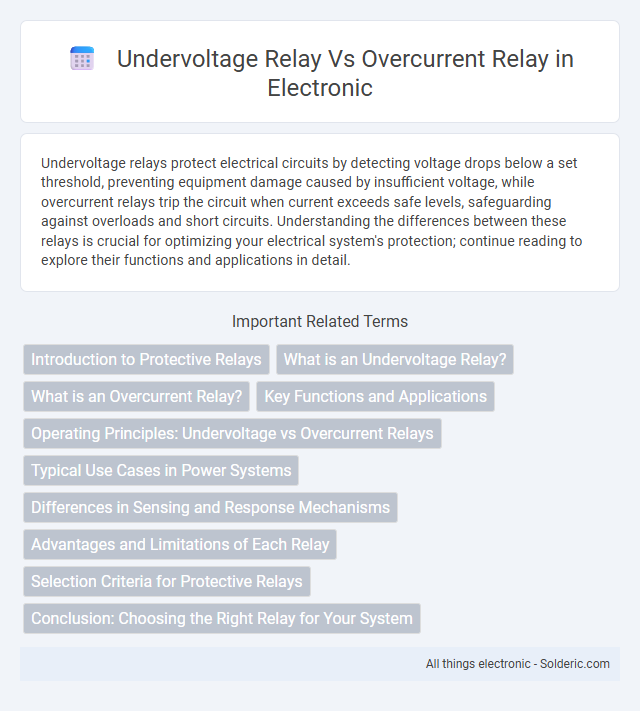Undervoltage relays protect electrical circuits by detecting voltage drops below a set threshold, preventing equipment damage caused by insufficient voltage, while overcurrent relays trip the circuit when current exceeds safe levels, safeguarding against overloads and short circuits. Understanding the differences between these relays is crucial for optimizing your electrical system's protection; continue reading to explore their functions and applications in detail.
Comparison Table
| Feature | Undervoltage Relay | Overcurrent Relay |
|---|---|---|
| Function | Detects voltage drops below preset levels | Detects current exceeding preset limits |
| Primary Use | Prevents equipment damage due to low voltage | Prevents overload and short-circuit damage |
| Application | Voltage-sensitive protection in power systems | Current-based protection in electrical circuits |
| Operation Principle | Monitors voltage level and trips on undervoltage | Measures current and trips on overcurrent |
| Typical Setting | Voltage threshold (e.g., 70-90% of nominal voltage) | Current threshold (e.g., 110-150% of rated current) |
| Response Time | Usually instantaneous or with delay | Instantaneous, definite time, or inverse time |
| Common Use Cases | Motors, transformers, power supplies | Generators, transformers, feeders, motors |
| Protection Against | Low voltage conditions causing malfunction | Overload, short circuits, and fault currents |
Introduction to Protective Relays
Protective relays are critical components in electrical power systems designed to detect abnormal conditions and initiate isolation of faulty sections to prevent equipment damage. Undervoltage relays monitor voltage levels and trigger tripping when voltage drops below preset thresholds, indicating issues like power supply failure or system faults. Overcurrent relays detect excessive current flow beyond safe limits, protecting circuits from overheating and potential damage by disconnecting affected parts.
What is an Undervoltage Relay?
An undervoltage relay is a protective device designed to monitor voltage levels and activate when voltage drops below a preset threshold, preventing equipment damage and system instability. It plays a critical role in electrical systems by disconnecting the load during low voltage conditions, safeguarding motors and transformers from operating under unsafe voltage. You can rely on undervoltage relays to enhance system reliability and avoid costly downtime caused by voltage sags or faults.
What is an Overcurrent Relay?
An Overcurrent Relay is a protective device designed to trip a circuit breaker when the current exceeds a predetermined threshold, preventing damage caused by excessive current flow in electrical systems. It operates based on the magnitude of current, responding to overloads and short circuits to safeguard equipment and maintain system stability. Unlike undervoltage relays, which monitor voltage levels, overcurrent relays specifically target abnormal current conditions for effective fault detection.
Key Functions and Applications
Undervoltage relays detect and respond to voltage drops below preset thresholds, protecting equipment from damage caused by insufficient voltage, commonly used in motor control and power distribution systems. Overcurrent relays monitor current levels exceeding set limits, promptly interrupting circuits during overload or short-circuit conditions to prevent thermal damage and fire hazards in electrical networks. These relays are essential for maintaining system stability and safety in industrial automation, power plants, and electrical substations.
Operating Principles: Undervoltage vs Overcurrent Relays
Undervoltage relays operate by detecting voltage levels that drop below a preset threshold, triggering protective actions to prevent equipment damage or system instability. Overcurrent relays monitor the current flow exceeding a specific rating, initiating trips to safeguard electrical devices from overheating or short circuits. Your choice between these relays depends on whether voltage dips or excessive current flow pose a greater risk to your electrical system.
Typical Use Cases in Power Systems
Undervoltage relays are typically used in power systems to protect motors and transformers by detecting voltage drops that could cause equipment malfunction or damage. Overcurrent relays are commonly employed to safeguard distribution lines and transformers from excessive current caused by short circuits or overloads. Both relays ensure system reliability by isolating faulty sections, minimizing damage and maintaining stable power delivery.
Differences in Sensing and Response Mechanisms
Undervoltage relays detect voltage drops below a preset threshold to protect electrical equipment from insufficient voltage conditions, triggering response mechanisms that isolate circuits when voltage falls. Overcurrent relays monitor current flow exceeding designated limits, responding by interrupting power to prevent damage from overloads or short circuits. The fundamental difference lies in undervoltage relays sensing voltage magnitude while overcurrent relays measure current intensity for system protection.
Advantages and Limitations of Each Relay
Undervoltage relays offer the advantage of protecting electrical equipment from low voltage conditions that can cause motor stalling or malfunction, but they may not detect overcurrent faults effectively. Overcurrent relays excel at identifying excessive current flow to prevent equipment damage and outages, yet they might fail to respond to voltage sags or drops that do not involve high current. Selecting the appropriate relay depends on the specific protection requirements, with undervoltage relays ensuring voltage stability and overcurrent relays providing robust thermal and fault current protection.
Selection Criteria for Protective Relays
Selection criteria for protective relays depend on the specific electrical parameters to be monitored; undervoltage relays are chosen when voltage stability is critical, protecting against voltage drops and ensuring supply continuity. Overcurrent relays are selected based on current thresholds to safeguard equipment from overloads and short circuits, with settings adjusted according to load characteristics and coordination with other protection devices. Both relay types require careful consideration of system voltage levels, load profiles, and fault conditions to ensure optimal protection and reliability.
Conclusion: Choosing the Right Relay for Your System
Selecting the appropriate relay depends on your system's specific protection needs: undervoltage relays safeguard against voltage drops that can damage sensitive equipment, while overcurrent relays protect circuits from excessive current that may cause overheating or faults. Evaluating the critical parameters such as voltage stability and current load ensures optimal relay performance and system reliability. Your choice should align with the primary threat to your electrical network to maximize safety and efficiency.
Undervoltage Relay vs Overcurrent Relay Infographic

 solderic.com
solderic.com